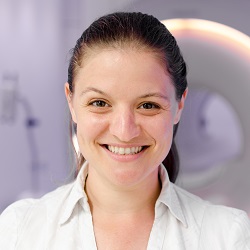Faculty DirectoryMolly Bright

Assistant Professor of Biomedical Engineering
Assistant Professor of Physical Therapy and Human Movement Sciences
Contact
645 N Michigan AveSuite 1100
Chicago, IL 60611
Email Molly Bright
Website
Departments
Education
D.Phil. Clinical Neurosciences, University of Oxford, Oxford, United Kingdom
B.S. Physics, Massachusetts Institute of Technology, Cambridge, MA
Research Interests
The Applied Neuro-Vascular Imaging Lab (ANVIL) focuses on developing advanced MRI techniques to assess the healthy function and interaction of neural activity and vascular physiology throughout the human central nervous system, with an emphasis on initial translation to patient populations. This involves the design and implementation of new tools and devices to stimulate, monitor, or enhance human physiology during MRI scanning, and the development of specialized MRI acquisition and modelling methods to characterize neurovascular signals in the brain, brainstem, and spinal cord. ANVIL aims to produce robust noninvasive imaging techniques to study individual patient pathophysiology in cohorts with impaired movement, including acute and chronic stroke, cerebral palsy, traumatic and degenerative spinal cord injury, and multiple sclerosis. Long term, we seek to use such personalized imaging approaches to study and optimize individual patient responses to rehabilitative interventions.
This research is in collaboration with Physical Therapy and Human Movement Sciences, Biomedical Engineering, Neurology, Radiology, the Center for Translational Imaging, the Northwestern University Interdepartmental Neuroscience program, and the Shirley Ryan Ability Lab.
Selected Publications
- Johnson, Hannah R.; Wang, Max C.; Stickland, Rachael C.; Chen, Yufen Jennie; Parrish, Todd B.; Sorond, Farzaneh A.; Bright, Molly G., Variable cerebral blood flow responsiveness to acute hypoxic hypoxia, Frontiers in Physiology (2025).
- Zvolanek, Kristina M.; Moore, Jackson E.; Jarvis, Kelly; Moum, Sarah J.; Bright, Molly G., Macrovascular blood flow and microvascular cerebrovascular reactivity are regionally coupled in adolescence, Journal of Cerebral Blood Flow and Metabolism (2025).
- Clements, Rebecca G.; Zvolanek, Kristina M.; Reddy, Neha A.; Hemmerling, Kimberly J.; Bayrak, Roza G.; Chang, Catie; Bright, Molly G., Quantitative mapping of cerebrovascular reactivity amplitude and delay with breath-hold BOLD fMRI when end-tidal CO2 quality is low, Imaging Neuroscience (2025).
- Reddy, Neha A.; Clements, Rebecca G.; Brooks, Jonathan C.W.; Bright, Molly G., Simultaneous cortical, subcortical, and brainstem mapping of sensory activation, Cerebral Cortex (2024).
- Hemmerling, Kimberly J.; Hoggarth, Mark A.; Sandhu, Milap S.; Parrish, Todd B.; Bright, Molly G., Spatial distribution of hand-grasp motor task activity in spinal cord functional magnetic resonance imaging, Human Brain Mapping (2023).
- Gong, Jingxuan; Stickland, Rachael C.; Bright, Molly G., Hemodynamic timing in resting-state and breathing-task BOLD fMRI, Neuroimage (2023).
- Zvolanek, Kristina M.; Moia, Stefano; Dean, Joshua N.; Stickland, Rachael C.; Caballero-Gaudes, César; Bright, Molly G., Comparing end-tidal CO2, respiration volume per time (RVT), and average gray matter signal for mapping cerebrovascular reactivity amplitude and delay with breath-hold task BOLD fMRI, Neuroimage (2023).
- Hoggarth, Mark A.; Wang, Max C.; Hemmerling, Kimberly J.; Vigotsky, Andrew D.; Smith, Zachary Adam; Parrish, Todd B.; Weber, Kenneth A.; Bright, Molly G., Effects of variability in manually contoured spinal cord masks on fMRI co-registration and interpretation, Frontiers in Neurology (2022).